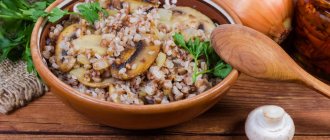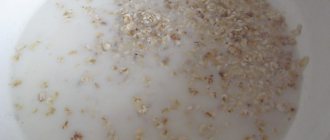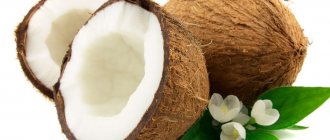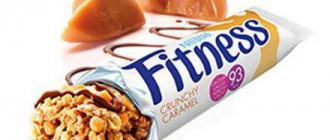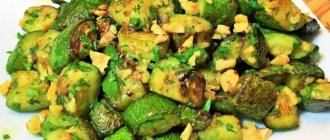How is coconut milk made?
Coconut milk comes in three types:
- first spin White, viscous. Contains a high concentration of fats and nutrients.
- second spin . To do this, primary processing products are filled with water. The result is a translucent liquid in which the content of useful substances is lower.
- powdered milk . To do this, the coconut pulp is evaporated and then ground to a powder. In this form, the product is used both in cooking and in cosmetology.
Coconut oil taste
Coconut oil is very delicate, creamy, and sweetish.
I admit, my kids and I love the taste of coconut oil. When I buy it for cosmetic purposes, they usually beg me for a spoon or two, and eat it just like that. I myself sometimes touch a coconut jar, not only for the purpose of beauty, but also to enjoy the taste of its contents.
And the taste of coconut oil is truly, as the famous advertisement says, “heavenly pleasure.”
It is very bright, intense, but at the same time delicate, a little creamy, slightly sweet, refreshing, creamy, buttery. It is difficult to confuse it with the taste of other products - it is so specific and recognizable.
The smell of this product is no less pleasant - it seems to envelop your olfactory organs and give them sweetness, tenderness, and creaminess. Well, and coconut, of course! How can this whole bouquet be used in cooking? Let's find out!
Back to contents
Composition and calorie content of coconut milk
Coconut milk is a low calorie product. 100 ml contains 230 kcal, canned - about 190 kcal. The product is rich in useful substances and microelements:
- cellulose;
- 24 amino acids;
- essential oils;
- antioxidants;
- polyunsaturated acids – Omega-3, Omega-6, Omega-9;
- mono- and disaccharides;
- vitamins A, B, C, PP, E, K;
- sodium, calcium, selenium, zinc, copper, phosphorus, iron.
How to choose and use
In addition to its beneficial properties, coconut oil has another advantage - a delicate, refreshing and light taste. Therefore, its use is not limited only to cosmetology. It is also suitable for eating. There are 2 types of oil on sale: refined and unrefined. The latter option has a pronounced coconut aroma. If a neutral taste is required, it is recommended to choose the first variety.
Unlike all vegetable oils, unrefined coconut oil has a solid structure that remains so at room temperature. In winter it becomes stone. Therefore, it must first be melted over low heat or a water bath.
The plant product can be added to salads, baked goods, ice cream, sauces, or spread neat on toast. Ideal for frying. Coconut oil melts at a temperature of +25°C . By adding a small amount of the product to warm milk or hot chocolate, an effective cold remedy is obtained.
Coconut oil is most often sold in frozen briquettes, which have a whitish or yellowish color. A quality product is uniform, without any inclusions or streaks. Fresh oil exudes a pleasant sweetish smell. It can be stored both in the closet and in the refrigerator. To do this, use glass or plastic containers with hermetically sealed lids. The main thing is to protect the oil from exposure to direct sunlight.
Benefits of coconut milk
The product has many beneficial properties due to its rich composition.
Improves digestion
Coconut milk is useful for preventing diseases of the stomach and intestines. The abundance of fiber helps speed up metabolism and remove processed foods from the body.
Improves health
The benefits of coconut milk for the health of the body cannot be overestimated. The absence of cholesterol distinguishes the product from milk of animal origin.
Lauric acid in the composition strengthens the immune system and fights viruses. Potassium helps regulate blood pressure. Phosphorus strengthens bones.
Canned milk
The canned product is most often sold on store shelves. You need to pay attention to the fact that manufacturers dilute components in different ways. Therefore, the calorie content of coconut milk for some brands may differ from others; the most common is 190-220 kcal.
The less preservatives it contains, the better.
Harm of coconut milk and contraindications
In European countries, coconut palms do not grow, therefore, milk comes to us in a ready-made, usually canned form. Like another exotic product that is not typical for the cuisine of the region where you live, it should be consumed with caution.
Firstly, to preserve the product, manufacturers use many preservatives and additives, which in large quantities can be harmful. Secondly, coconut milk is not recommended for food if:
- individual intolerance;
- allergic reactions;
- hyperthyroidism.
Coconut milk can cause harm to the body only if individual contraindications are neglected.
Description of coconut oil
Coconut oil
As the name of this product suggests, it comes from coconuts, but there's a reason these large nuts are crushed whole. First, the seeds are extracted from green fruits - these are the same hairy brown parts that we usually think of as nut shells.
For this purpose, coconut oil producers have adapted a special tool that resembles nippers - the nut is placed on them, then they are opened, and after them, the coconut itself breaks into two halves.
Secondary endosperm is extracted from it using another special device, similar to a citrus crusher. This is such a very valuable substance that surrounds the embryo and nourishes it in every possible way (it turns out that it is similar to our placenta?). Of course, it contains a lot of vital substances - proteins, starches, vegetable oils.
In coconut it is called copra (“coppara”). This is how she was called in the Indian language Malayalam. So, this same copra is extracted from ripe nuts, laid out on cloth or on special wooden platforms, and then dried in the sun.
Then these raw materials are placed under a press - manual or mechanized. The second looks like a machine with electronic or manual control and a diesel engine. It is this cold method of squeezing coconut oil that is considered the best, since the resulting oily substance has almost all the properties of a fresh nut - taste, aroma, and a set of nutrients.
Most unrefined cold-pressed coconut oil is produced using such machines, but there are also some products that are extracted from copra by hand. It is the most expensive, but also the most valuable. Have you seen this kind of butter on sale?
Another way to obtain this product is by boiling it from the pulp.
For this purpose, copra is not pre-dried, but immediately turns into shavings. Milk is squeezed out of this aromatic crumb, and then it is boiled for quite a long time over low heat, stirring continuously. Over time, the liquid coagulates, thickens, and acquires a rich brown color. During the processing process, you can see how the butter is separated from the milk, and brown chips are fried on it. Once it becomes crispy, the oil is filtered out of it. And the leftovers are mixed with honey and eaten.
Of course, this method of preparing a product cannot be called environmentally friendly, but it also exists and also gives us coconut oil. By the way, you can make butter at home this way. Even less gentle is the method of refining the oil substance, when it is purified from natural impurities using high temperatures and chemicals. In addition, for this type of product, not valuable copra is often used, but all kinds of coconut waste.
Often, in order to increase the shelf life of the oil, it is purified from a number of fatty acids in the composition, the moisture is evaporated for a long time, and finally citric acid and salt are added to the oil as preservatives.
And in order to increase the melting point of the product, manufacturers hydrogenate it, which makes the fatty acids more saturated and turns some of them into harmful trans fats that are not digested by the body. Is it delicious?

